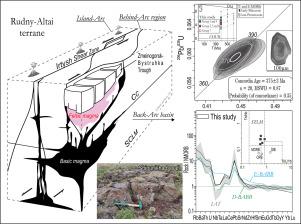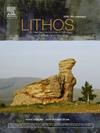中亚鲁德尼阿尔泰西北部希普尼克哈洼地与纪元-新生代断裂有关的火山活动:构造-岩浆学意义以及对全岩石地球化学、钕同位素数据和 UPb 年龄的新约束
IF 2.9
2区 地球科学
Q2 GEOCHEMISTRY & GEOPHYSICS
引用次数: 0
摘要
本文提供了关于鲁德阿尔泰泥盆纪断裂相关火山活动的新原始数据,鲁德阿尔泰是西伯利亚大陆(阿尔泰-萨彦褶皱带,中亚造山带西部)的一个边缘陆相。与大陆边缘构造-岩浆再活化有关的延伸机制伴随着双峰型浅海火山活动的强烈爆发和亚火山侵入体的注入。在第一阶段,基本岩浆活动从(i)注入 "富含更多 LREE 和 HFSE "的辉绿岩(εNd(t) = +5.1)发展到(ii)喷出其类似物(εNd(t) =+1.4),然后是 "富含更少 LREE 和 HFSE "的玄武岩(εNd(t) = +6.1)。这一阶段反映了裂谷的初步打开。在第二阶段,火山活动从(iii) "LREE-和HFSE-贫化 "型(εNd(t) = +5.4)演变为(iv) "LREE-富集和HFSE-贫化 "型(εNd(t) = +4.1至+4.7)。这一阶段与拉开海盆的长期开放相对应,因为在此期间没有地质证据表明岛弧隆升。指标高频扫描比(Th/Yb、Nb/Yb 和 Zr/Y)的变化、Nb 相对于 La 和 Th 的富集以及适度的 Nd 同位素值与弧后地区的玄武岩相似,与断裂的时空关系密切。痕量元素的变化表明地幔源的部分熔融程度发生了变化,从较低到较高,这与渐进式断裂是一致的。岩浆的岩石成因被解释为岩石圈地幔的浅层熔融,由先前的俯冲事件和继承的残余地幔的地球化学特征代谢而成。大量长粒岩浆是岩石圈延伸过程中地壳熔融形成的,当时碱性岩浆达到地壳高位。白云母的锆石 UPb 年龄约为 375 Ma,反映了火山活动的高峰期。摘要西伯利亚大陆阿尔泰汇聚边缘(鲁德尼阿尔泰西北部)泥盆纪的演化伴随着玄武岩-英安岩火山活动的产生(∼380-375 Ma)。根据火山相的序列及其在时间范围内的地球化学变化,可将拉开盆地的开辟分为初始和长期两个阶段。岩浆的岩石成因被解释为岩石圈地幔在之前的俯冲事件中变质后的浅层熔融,并继承了残余地幔的地球化学特征。通过改变岩浆源的部分熔化程度,从较低到较高,可以再现最初和随后的岩浆阶段,这与拉开盆地的演化相一致。与裂谷有关的岩浆活动是由弧和弧后板块平移引起的,俯冲因素作用较小。本文章由计算机程序翻译,如有差异,请以英文原文为准。

Givetian-Frasnian rift-related volcanism of the Shipunikha Depression, NW Rudny Altai, Central Asia: Tectono-magmatic significance and new constraints on whole-rock geochemistry, Nd-isotopic data and UPb ages
The paper presents new original data on the Devonian rift-related volcanism from the Rudny Altai, a marginal terrane of the Siberian continent (Altai-Sayan Fold Belt, western Central Asian Orogenic Belt). The extensional regime in relation to tectono-magmatic reactivation of the continental margin was accompanied by an intense flare up of bimodal-type shallow-marine volcanism and injection of subvolcanic intrusions. On the first stage basic magmatism evolved from (i) injection of “More LREE- and HFSE-enriched” dolerite (εNd(t) = +5.1) to (ii) eruption of their effusive analogues (εNd(t) = +1.4), and following “Less LREE- and HFSE-enriched” basalt (εNd(t) = +6.1). This stage reflects initial opening of the rift. On the second stage, volcanism evolved from (iii) “LREE- and HFSE-depleted” (εNd(t) = +5.4) to (iv) “LREE-enriched and HFSE-depleted” (εNd(t) = +4.1 to +4.7) types. This stage correspond to the prolonged opening of the pull-apart basin, as there is no geological evidence for island-arc uplift during this period. Variations in indicator HFSE ratios (Th/Yb, Nb/Yb and Zr/Y), enrichment of Nb relative to La and Th in combination with moderate Nd isotopic values resemble those for basalts from the behind-arc region with close spatial-temporal relation to rifting. The trace element variation indicates a change in the partial melting degree of the mantle source, from lower to higher, consistent with progressive rifting. The petrogenesis of magmas has been interpreted as shallow melting of a lithospheric mantle, metosomatised by a previous subduction event, and inherited geochemical signatures of relict mantle. The voluminous felsic magmatism was formed by crustal melting during lithospheric extension when basic magmas reached high crustal levels. The dacites yield zircon U![]() Pb ages of ca. 375 Ma, reflecting the peak of volcanic activity. The tectonic record bear evidence of strike-slip deformation, which could been induced by translation of arc and back-arc lithospheric plates.
Pb ages of ca. 375 Ma, reflecting the peak of volcanic activity. The tectonic record bear evidence of strike-slip deformation, which could been induced by translation of arc and back-arc lithospheric plates.
Summary
The Devonian evolution of the Altai Convergent Margin (NW Rudny Altai) of the Siberian continent was accompanied by the generation of basalt-dacite volcanism (∼380-375 Ma). Based on the sequence of volcanic phases and their geochemical variations in the time range, two stages corresponding to the initial and long-term opening of the pull-apart basin are distinguished. The petrogenesis of the magmas is interpreted as shallow melting of lithospheric mantle metasomatised by a previous subduction event and inheriting geochemical signatures of the relict mantle. The initial and subsequent magmatic phases can be reproduced by varying the degree of partial melting of the magma source from lower to higher, consistent with the evolution of the pull-apart basin. Rift-related magmatism is caused by arc and back-arc plate translation, with a minor role for subduction factor.
求助全文
通过发布文献求助,成功后即可免费获取论文全文。
去求助
来源期刊

Lithos
地学-地球化学与地球物理
CiteScore
6.80
自引率
11.40%
发文量
286
审稿时长
3.5 months
期刊介绍:
Lithos publishes original research papers on the petrology, geochemistry and petrogenesis of igneous and metamorphic rocks. Papers on mineralogy/mineral physics related to petrology and petrogenetic problems are also welcomed.
 求助内容:
求助内容: 应助结果提醒方式:
应助结果提醒方式:


